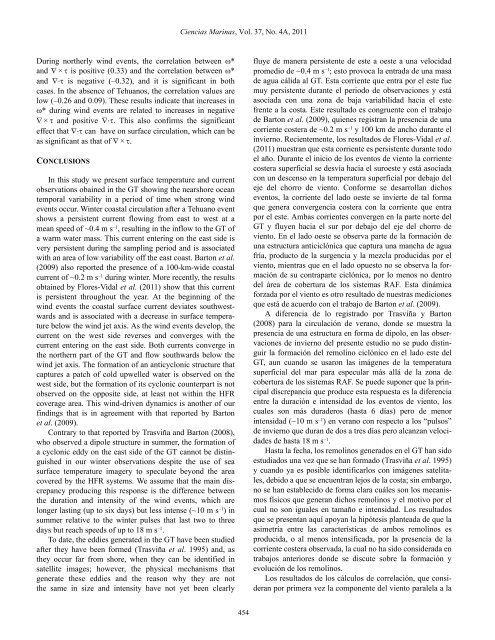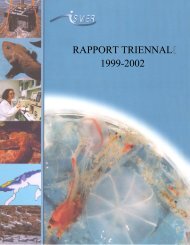Wind-driven coastal circulation in the Gulf of Tehuantepec, Mexico ...
Wind-driven coastal circulation in the Gulf of Tehuantepec, Mexico ...
Wind-driven coastal circulation in the Gulf of Tehuantepec, Mexico ...
You also want an ePaper? Increase the reach of your titles
YUMPU automatically turns print PDFs into web optimized ePapers that Google loves.
Ciencias Mar<strong>in</strong>as, Vol. 37, No. 4A, 2011Dur<strong>in</strong>g nor<strong>the</strong>rly w<strong>in</strong>d events, <strong>the</strong> correlation between *and × is positive (0.33) and <strong>the</strong> correlation between *and is negative (–0.32), and it is significant <strong>in</strong> bothcases. In <strong>the</strong> absence <strong>of</strong> Tehuanos, <strong>the</strong> correlation values arelow (–0.26 and 0.09). These results <strong>in</strong>dicate that <strong>in</strong>creases <strong>in</strong>* dur<strong>in</strong>g w<strong>in</strong>d events are related to <strong>in</strong>creases <strong>in</strong> negative × and positive . This also confirms <strong>the</strong> significanteffect that can have on surface <strong>circulation</strong>, which can beas significant as that <strong>of</strong> × .CONCLUSIONSIn this study we present surface temperature and currentobservations oba<strong>in</strong>ed <strong>in</strong> <strong>the</strong> GT show<strong>in</strong>g <strong>the</strong> nearshore oceantemporal variability <strong>in</strong> a period <strong>of</strong> time when strong w<strong>in</strong>devents occur. W<strong>in</strong>ter <strong>coastal</strong> <strong>circulation</strong> after a Tehuano eventshows a persistent current flow<strong>in</strong>g from east to west at amean speed <strong>of</strong> ~0.4 m s –1 , result<strong>in</strong>g <strong>in</strong> <strong>the</strong> <strong>in</strong>flow to <strong>the</strong> GT <strong>of</strong>a warm water mass. This current enter<strong>in</strong>g on <strong>the</strong> east side isvery persistent dur<strong>in</strong>g <strong>the</strong> sampl<strong>in</strong>g period and is associatedwith an area <strong>of</strong> low variability <strong>of</strong>f <strong>the</strong> east coast. Barton et al.(2009) also reported <strong>the</strong> presence <strong>of</strong> a 100-km-wide <strong>coastal</strong>current <strong>of</strong> ~0.2 m s –1 dur<strong>in</strong>g w<strong>in</strong>ter. More recently, <strong>the</strong> resultsobta<strong>in</strong>ed by Flores-Vidal et al. (2011) show that this currentis persistent throughout <strong>the</strong> year. At <strong>the</strong> beg<strong>in</strong>n<strong>in</strong>g <strong>of</strong> <strong>the</strong>w<strong>in</strong>d events <strong>the</strong> <strong>coastal</strong> surface current deviates southwestwardsand is associated with a decrease <strong>in</strong> surface temperaturebelow <strong>the</strong> w<strong>in</strong>d jet axis. As <strong>the</strong> w<strong>in</strong>d events develop, <strong>the</strong>current on <strong>the</strong> west side reverses and converges with <strong>the</strong>current enter<strong>in</strong>g on <strong>the</strong> east side. Both currents converge <strong>in</strong><strong>the</strong> nor<strong>the</strong>rn part <strong>of</strong> <strong>the</strong> GT and flow southwards below <strong>the</strong>w<strong>in</strong>d jet axis. The formation <strong>of</strong> an anticyclonic structure thatcaptures a patch <strong>of</strong> cold upwelled water is observed on <strong>the</strong>west side, but <strong>the</strong> formation <strong>of</strong> its cyclonic counterpart is notobserved on <strong>the</strong> opposite side, at least not with<strong>in</strong> <strong>the</strong> HFRcoverage area. This w<strong>in</strong>d-<strong>driven</strong> dynamics is ano<strong>the</strong>r <strong>of</strong> ourf<strong>in</strong>d<strong>in</strong>gs that is <strong>in</strong> agreement with that reported by Bartonet al. (2009).Contrary to that reported by Trasviña and Barton (2008),who observed a dipole structure <strong>in</strong> summer, <strong>the</strong> formation <strong>of</strong>a cyclonic eddy on <strong>the</strong> east side <strong>of</strong> <strong>the</strong> GT cannot be dist<strong>in</strong>guished<strong>in</strong> our w<strong>in</strong>ter observations despite <strong>the</strong> use <strong>of</strong> seasurface temperature imagery to speculate beyond <strong>the</strong> areacovered by <strong>the</strong> HFR systems. We assume that <strong>the</strong> ma<strong>in</strong> discrepancyproduc<strong>in</strong>g this response is <strong>the</strong> difference between<strong>the</strong> duration and <strong>in</strong>tensity <strong>of</strong> <strong>the</strong> w<strong>in</strong>d events, which arelonger last<strong>in</strong>g (up to six days) but less <strong>in</strong>tense (~10 m s –1 ) <strong>in</strong>summer relative to <strong>the</strong> w<strong>in</strong>ter pulses that last two to threedays but reach speeds <strong>of</strong> up to 18 m s –1 .To date, <strong>the</strong> eddies generated <strong>in</strong> <strong>the</strong> GT have been studiedafter <strong>the</strong>y have been formed (Trasviña et al. 1995) and, as<strong>the</strong>y occur far from shore, when <strong>the</strong>y can be identified <strong>in</strong>satellite images; however, <strong>the</strong> physical mechanisms thatgenerate <strong>the</strong>se eddies and <strong>the</strong> reason why <strong>the</strong>y are not<strong>the</strong> same <strong>in</strong> size and <strong>in</strong>tensity have not yet been clearlyfluye de manera persistente de este a oeste a una velocidadpromedio de ~0.4 m s –1 ; esto provoca la entrada de una masade agua cálida al GT. Esta corriente que entra por el este fuemuy persistente durante el periodo de observaciones y estáasociada con una zona de baja variabilidad hacia el estefrente a la costa. Este resultado es congruente con el trabajode Barton et al. (2009), quienes registran la presencia de unacorriente costera de ~0.2 m s –1 y 100 km de ancho durante el<strong>in</strong>vierno. Recientemente, los resultados de Flores-Vidal et al.(2011) muestran que esta corriente es persistente durante todoel año. Durante el <strong>in</strong>icio de los eventos de viento la corrientecostera superficial se desvía hacia el suroeste y está asociadacon un descenso en la temperatura superficial por debajo deleje del chorro de viento. Conforme se desarrollan dichoseventos, la corriente del lado oeste se <strong>in</strong>vierte de tal formaque genera convergencia costera con la corriente que entrapor el este. Ambas corrientes convergen en la parte norte delGT y fluyen hacia el sur por debajo del eje del chorro deviento. En el lado oeste se observa parte de la formación deuna estructura anticiclónica que captura una mancha de aguafría, producto de la surgencia y la mezcla producidas por elviento, mientras que en el lado opuesto no se observa la formaciónde su contraparte ciclónica, por lo menos no dentrodel área de cobertura de los sistemas RAF. Esta d<strong>in</strong>ámicaforzada por el viento es otro resultado de nuestras medicionesque está de acuerdo con el trabajo de Barton et al. (2009).A diferencia de lo registrado por Trasviña y Barton(2008) para la circulación de verano, donde se muestra lapresencia de una estructura en forma de dipolo, en las observacionesde <strong>in</strong>vierno del presente estudio no se pudo dist<strong>in</strong>guirla formación del remol<strong>in</strong>o ciclónico en el lado este delGT, aun cuando se usaron las imágenes de la temperaturasuperficial del mar para especular más allá de la zona decobertura de los sistemas RAF. Se puede suponer que la pr<strong>in</strong>cipaldiscrepancia que produce esta respuesta es la diferenciaentre la duración e <strong>in</strong>tensidad de los eventos de viento, loscuales son más duraderos (hasta 6 días) pero de menor<strong>in</strong>tensidad (~10 m s –1 ) en verano con respecto a los “pulsos”de <strong>in</strong>vierno que duran de dos a tres días pero alcanzan velocidadesde hasta 18 m s –1 .Hasta la fecha, los remol<strong>in</strong>os generados en el GT han sidoestudiados una vez que se han formado (Trasviña et al. 1995)y cuando ya es posible identificarlos con imágenes satelitales,debido a que se encuentran lejos de la costa; s<strong>in</strong> embargo,no se han establecido de forma clara cuáles son los mecanismosfísicos que generan dichos remol<strong>in</strong>os y el motivo por elcual no son iguales en tamaño e <strong>in</strong>tensidad. Los resultadosque se presentan aquí apoyan la hipótesis planteada de que laasimetría entre las características de ambos remol<strong>in</strong>os esproducida, o al menos <strong>in</strong>tensificada, por la presencia de lacorriente costera observada, la cual no ha sido considerada entrabajos anteriores donde se discute sobre la formación yevolución de los remol<strong>in</strong>os.Los resultados de los cálculos de correlación, que consideranpor primera vez la componente del viento paralela a la454




